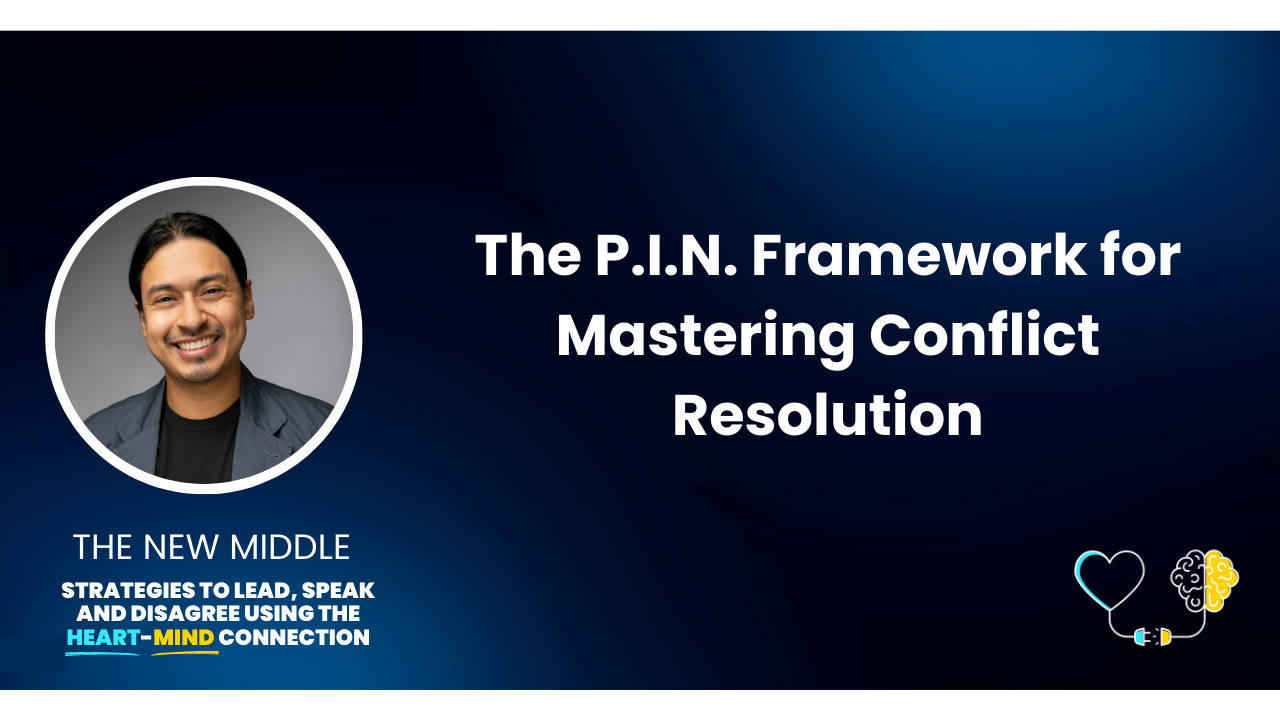
The P.I.N. Framework for Mastering Conflict Resolution
Bryant Galindo
Founder, CollabsHQ ? Mediator, Executive Coach, Consultant ? Author, The New Middle: Connecting Heart and Mind to Collaboratively Disagree ????
Welcome back to The New Middle, a resource for helping you develop conflict resolution and communication skills using the heart-mind connection based on?my book ?with the same name. Click subscribe above to be notified of future editions.
An executive I am working with asked me to do a half-day workshop for her team on emotional intelligence, assertive communication, and conflict resolution.
As I sat with what to teach them, I thought to myself, "What would combine all three of these topics into one?"
My answer: the P.I.N. Framework of Conflict Resolution.
What is the P.I.N. Framework of Conflict Resolution?
To practice the process of conflict, we must completely abandon the goal of getting people to do what we want. – Marshal Rosenberg, Mediator, Author, Teacher
I love the P.I.N. Framework because it requires good communication skills on your part to be effective (i.e., active listening skills + asking open-ended questions) to recognize the interests and needs of another.
This, if done well, provides the basis for potential conflict resolution.
Most disagreements occur because of misunderstandings. The P.I.N. framework provides a basis for helping us to understand how to correct those misunderstandings by getting to the deeper issues that drive arguments and conflict.
Within any disagreement, there are three levels someone should be listening for: a person's positions, interests, and needs.
When we get locked into battles of he said, she said, or try to win an argument or disagreement, we get tunnel vision and stay at the positional level.
This in turn creates situations where we began dehumanizing the other side, "othering" them essentially, so it makes it easy to argue and avoid taking into account what the other side wants.
Within the interests and needs level, however, there is greater potential for successful conflict resolution; it is there that you can get to the heart of the disagreement and why someone wants what they want.
The classic example of what this looks like is the story of a baker and chef who were fighting over an orange:
"A baker and a chef are in a kitchen fighting over the last orange. Both need an orange to complete their respective recipes. With neither moving from their position, enter a third person, a sous chef. He asks each person, "Why do you need the orange?" The baker needs the rind of the orange for his pie while the chef needs the juice for his orange chicken recipe. Satisfied with this information, the sous chef cuts the rind of the orange for the baker while then squeezing the juice for the chef."
By simply asking one why question, the sous chef was able to uncover critical information that created a solution that equally satisfied both parties.
Sounds simple, huh?
Well it can be, if you use the P.I.N. Model to stay curious and get to those deeper motivations.
How to Use the P.I.N. Model to Master Conflict Resolution
领英推荐
The New Middle asks you to escape the drama and dysfunction of disagreements and instead seek to understand first the deeper why of what drives a person to want something.
Think of each person having their own separate "P.I.N.", like how you see below.
As people dive deeper into a problem, and look at each person's interests and needs, you begin to see overlap between each person's interests and needs.
Why is that?
It's because, as reflected by Maslow's Hierarchy of Needs, we all have the same needs: to be seen, heard, respected, valued, validated, loved, and so much more.
The problem is that vocalizing these needs can feel vulnerable – and in a conflict situation, people may not want to say something that they think can be used against them.
But therein lies the secret sauce to conflict resolution: when we let go of our armor, get curious, and are willing to show up and see what the deeper interests and needs may be, we can more effectively create win-win solutions.
Bottom Line: Focus on Interests and Needs Instead of Positions to Master Conflict Resolution
When we're in the heat of an argument, disagreeing with someone, or in a full-blown conflict, it can feel difficult to get to the interests and needs.
But asking what, why, how, when, and other open-ended questions can start the exploration toward different options, generate creative solutions, and stimulate value for both sides.
It is from here that you can create a new middle, potentially solving the issue in a way that creates a win-win for all ??
___________
This article is inspired from my book "The New Middle: Connecting Heart and Mind to Collaboratively Disagree," available to purchase on?Amazon ?and?Barnes & Noble . You can learn more about the book?here .
___________
Other articles from?The New Middle?that you might be interested in:
___________
Bryant Galindo ?is the Founder of?CollabsHQ , whose mission it is to help business leaders navigate complex problems easily ??
Helping clients use their corporate and individual culture to create innovative change in their lives, community and businesses through coaching, workshops, and talks.
1 年Congrats on making the top 30 Latino Professionals List! Will buy your book!
Embodied Liberation Coach & Facilitator. I help intuitive BIPOC Changemakers embody liberation through transforming their relationships with themselves and in community
1 年I find this list of needs helpful in identifying them: https://baynvc.org/list-of-needs/
Resolving Conflict, Negotiation, and Communication | Executive & Leadership Coaching | Mediation | Facilitation | Training | OD
1 年Love this!